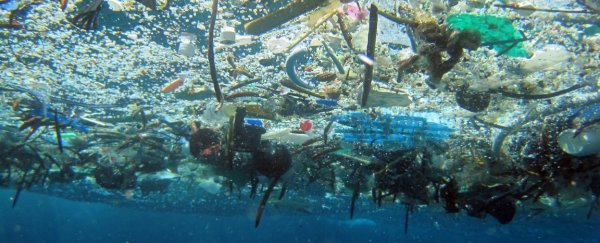We've long been aware that we have a problem with the amount of plastic in our ocean. Not only is it choking wildlife, it's also contaminating our food chain.
But there hasn't been a definitive number put on the amount of waste that we have to deal with, until now.
A new global study, led by the not-for-profit 5 Gyres Institute, has now quantified the problem - and the results are pretty depressing.
Publishing in PLOS One, the team estimates that there are now 5.25 trillion pieces of large and small plastic, weighing around 269,000 tonnes, throughout the world's oceans.
The study was conducted by scientists from six countries and involved data from 24 expeditions around the world, spread out over a six-year period, from 2007 to 2013.
After collecting plastic using nets and also conducting visual surveys on the amount of plastic waste across the oceans, the researchers, led by Marcus Eriksen, used computer models to estimate the total worldwide figure.
The research also found that, by far, the ocean's largest source of plastic by weight in the ocean comes from old fishing nets and buoys, but there are also plenty of old toothbrushes, bottles, plastic bags and other rubbish.
However, this plastic isn't just floating on the surface.
The studies revealed that, while large plastics are common near coastlines, they quickly break down into small fragments once they get carried to one of the ocean's five subtropical gyres - regions in the ocean where currents collide.
In these gyres, plastic waste comes together and bashes up against each other in the waves and the Sun and eventually break down into tiny confetti-sized pieces. Eriksen describes them as "shredders" for the plastic.
What the researchers weren't expecting was how far these microplastics seem to be spreading - in fact, they were found in more remote regions, including subpolar gyres.
"Our findings show that the garbage patches in the middle of the five subtropical gyres are not the final resting places for the world's floating plastic trash," said Eriksen in a press release. "The endgame for microplastic is interactions with entire ocean ecosystems."
Even more worrying is the fact that many of these small pieces of microplastics are "missing". Even though the team was looking for floating bits of plastic as small as a grain of sand, they couldn't find the volume that their models told them was there.
In fact, they found one-hundredth as many particles as their models predicted.
A paper published earlier this year in the Proceedings of the National Academy of Sciences also came up with a similar result. Led by Andrés Cózar from the University of Cadiz in Spain, the team had expected to find million of tonnes of plastic across the ocean, but they could only find 35,000.
Eriksen told John Schwartz at the New York Times that this suggests that the smaller bits of plastic are being swept deeper into the ocean or are being eaten by marine organisms.
Although the two research teams came up with different final amounts, they both agree on one thing - there's too much plastic in the ocean.
Cózar told Schwartz: "The current model of management of plastic materials is (economically and ecologically) unsustainable."
Eriksen explained to the New York Times that he hopes the next step will be manufacturers taking more responsibility for where their products end up and the damage they're doing. Some countries have already banned the small microbeads in body washes and other cleansing products, but we've got a long way to go.
Still, having an estimate of the size of the problem definitely helps.
Source: Phys.org, New York Times
